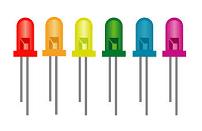 The term diode derives from a Greek word that can be translated as “narrow passage.” The concept is used in the field of electricity to name the valve that has a pair of electrodes and only allows the passage of current in a single direction .
The term diode derives from a Greek word that can be translated as “narrow passage.” The concept is used in the field of electricity to name the valve that has a pair of electrodes and only allows the passage of current in a single direction .
To understand what a diode is, therefore, we must know what electrodes are. This is the name given to the end of an electrical conductor that is linked to a medium, from which it receives or to which it transmits a current .
Diodes are electronic parts that have two electrodes and that allow the electric current to advance in only one direction. Up to a certain potential difference, diodes function as an open circuit that do not conduct electricity ; On this difference, however, they act as a closed circuit whose resistance is very low.
The first diodes were known as vacuum diodes , since they were glass tubes made up of two electrodes that were surrounded by vacuum . These diodes were designed by the English engineer John Ambrose Fleming (1848-1945) at the beginning of the 20th century.
Over time, vacuum diodes fell out of use and were replaced by semiconductor diodes . In this case, the valves have a semiconductor material that is linked to the electrodes. Types of semiconductor diodes include silicon diodes , crystal diodes , light-emitting diodes , avalanche diodes , and thermal diodes .
Light-emitting diodes, known by the English acronym LED , are characterized by the possibility of emitting light, producing a wavelength that varies from infrared to almost ultraviolet. Due to low energy consumption, low heat emission, long lifespan and small size, light-emitting diodes are an increasingly used lighting source.
As mentioned in previous paragraphs, the diode conducts current in only one direction , and this represents its most characteristic feature. As with many other creations that were revolutionary in their time, it is not necessary to thoroughly understand how it works from a physical point of view or how the diode is manufactured to be able to use it, even in highly complex circuits.
 The nonlinear equation that can be seen in the second image shows us how to model the so-called IV curve of a diode , where i is the diode, Is is the reverse saturation current (in the case of silicon, it is usually 10 to the power to minus 12 amperes), q represents the charge of the electron, k is the Boltzmann constant and T , the temperature in kelvin.
The nonlinear equation that can be seen in the second image shows us how to model the so-called IV curve of a diode , where i is the diode, Is is the reverse saturation current (in the case of silicon, it is usually 10 to the power to minus 12 amperes), q represents the charge of the electron, k is the Boltzmann constant and T , the temperature in kelvin.
One of the fundamental concepts in this context is the forward current , which occurs if a positive voltage is set by means of a silicon diode, placing us to the right of curve IV. For a low value, such as +0.2 volts, there is almost no forward current, while when we reach +0.6 volts it is already possible to make a measurement. Past that value, the current increases rapidly, making the curve practically vertical.
This allows us to understand that the diode's IV curve is not linear. The polarization is direct when the voltage between its two terminals is positive, as in the previous example.
To represent a diode, it is necessary to express the direction in which the current and voltage advance (which must also have the + and – signs to indicate the orientation, with the positive end receiving the forward current). An orange curve should also be drawn to highlight the polarity of the voltage. All this can be seen in the second image.
